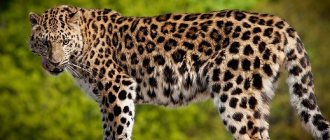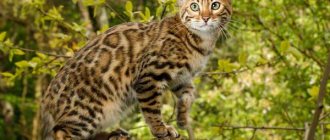Cheetah's maximum speed
The maximum jump of a cheetah can reach 6 m
The cheetah is considered the fastest land animal. It can reach speeds of up to 110 km/h, and within 2 seconds after the start it reaches 65 km/h! However, he is not a stayer, but rather a sprinter. A cheetah's run is a series of throws, the distance of each of which is just over 400 m. After running a mini-distance, the animal must rest to gain strength.
This is explained by the habitat and hunting habits of the animal. The cheetah lives in open areas where there is no opportunity to hide in an ambush, so it overtakes its prey in pursuit. First, he approaches the potential victim at 10 meters, and then catches him in a high-speed race.
Description of the leopard
Leopard is a large cat. Possesses flexibility and amazing ability to hide. Having a spotted yellow skin, he, like the lynx, is able to completely blend in with the branches and grass. Sometimes his hanging tail gives him away. This is a strong animal, but in terms of power it is inferior to the lion and tiger.
Not a single representative of the feline is capable of silently and deftly sneaking up on prey. The leopard is considered the most cunning cat. To lure prey to him, he can spend many hours in the sun, pretending to be dead. They tolerate heat and cold very well, even temperatures below zero.
It is a mistake to consider a leopard and a panther to be different animals. Panthers are dark-colored leopards. Color - from straw color to rusty brown. Young individuals have a lighter color: yellow, closer to grayish. Color depends on habitat and seasonality. The spots on the skin are ring-shaped and are called “rosettes.” Dark rings may not be interrupted. The boundaries of the spots are sharp, their location is unique for each animal, like prints for a person.
The animal is active at night. They are loners: they live and hunt on their own. After birth, they quickly adapt, showing their first hunting abilities. At first they are born blind, but gradually their vision becomes sharper. They are able to see the victim at a distance of 1.5 kilometers.
The animal makes a variety of sounds: hissing, growling, sounds in the form of screams and coughing.
The length of the body without the tail is 90-190 cm, while the tail ranges from 60 to 110 cm. The size depends on the habitat. Height at the withers is up to 80 cm. Weight ranges from 30 to 80 kilograms. Favorite animal food: young buffaloes, antelopes. Silently creeping up, makes a jump from close range. The main technique is to bite the scruff of the neck and throw it to the ground. Depending on the size of the victim, he hides with it or drags it up a tree.
How fast does a leopard run?
Predators can make huge leaps up to 7 m in length and 3 m in height
Unlike the cheetah, the leopard is a forest dweller. The abundance of tall grass and bushes gives the predator the opportunity to hide and watch the approach of the prey from ambush. When attacking prey, it pursues it at a speed of 60 km/h, without having to run far.
Lifestyle
The cheetah is considered one of the most peaceful big cats. They almost never attack people, unlike leopards. Lions, tigers and cheetahs often appear in circuses, while leopards appear extremely rarely. These freedom-loving cats are cruel, vindictive and cannot be trained. African hunters consider the leopard the most dangerous predator for humans.
The cheetah hunts due to its incredible speed; it can accelerate to 115 km/h within a few seconds. But such a sprint requires enormous energy expenditure and does not last long - if the cheetah cannot quickly overtake the prey, it stops pursuing. Leopards hunt by waiting in ambush or sneaking as close to their prey as possible, then jumping and strangling it. Leopards usually try to drag their prey higher to ensure its safety, but cheetahs do not do this. Leopards tend to hunt at dusk so they can be hidden from their ambush. The cheetah prefers to hunt during the day, so it is easier to catch up with the prey. Leopards are solitary by nature and hunt alone. Cheetahs may well go out hunting in a pack.
Cheetah, leopard and jaguar are some of the large cats that live in Africa, Asia and America.
ANSWER:
A leopard can reach a maximum running speed of up to 50 km per hour. This is a rather modest result compared to the fastest land animal on the planet - the cheetah, which can reach more than 110 km per hour.
Leopards do not lose energy. Instead of chasing at high speeds, they chase and lure their prey. First of all, the prey of the leopard are antelopes, rodents and warthogs. The main enemies of these animals include lions, tigers and people.
Leopards live in Africa and Asia, where people hunt them for their fur and meat. The lifespan of a leopard is 10-15 years, and sexual maturity occurs at the age of 20-24 months.
Wild cats are fast and agile animals that are excellent hunters. Even a domestic cat can run at a speed of 40 km per hour. The pet will not be able to cover a long distance at this pace. He will be able to make a tiny leap. Wild cats have greater endurance, so they are able to run at high speed for much longer.
When measuring indicators, the distance and time it takes the animal to cover the distance are taken into account. There are many cats in nature that are capable of running with incredibly high agility.
Description of the features of the Cheetah
The cheetah, which lives on Earth today and is the only representative of its genus, descended from Acinonyx, a specific cat-like predator that lived about three million years ago.
All existing species of cats, both small and very large, such as the cave lion and saber-toothed tiger, hunted their victims, waiting for them in ambush, hiding and making one deadly leap.
Acinonyx hunted differently; he chased game, like a wolf or a wild dog.
Most likely, the change in hunting method was provoked by climate change. After the end of the Ice Age, a sharp warming occurred, most forests simply died in drought, and the surface of the planet turned into a dried-out steppe.
Most wild cats, having lost their usual way of hunting, became extinct; Acinonyxes managed to adapt to the changed conditions of existence and turned into excellent sprinters. After all, in the steppe there was nowhere to hide, to hide, or to ambush the intended victim. It was possible to get food only by chasing prey.
For a long time, future Cheetahs successfully developed and reproduced over a large territory of the Old World - from Western Europe to the territory of future China, from the southern borders of Africa to the Siberian forests.
Sixth place – Puma
The predator runs very quickly over short distances. The animal is capable of reaching speeds of up to 75 km/h. That is, a cougar can even catch up with a car that is not going too fast.
In the United States of America, the cougar is commonly called the “mountain lion.” The name is associated with the animal's habitat. The predator can be found not only in forests, but also in the mountains. Moreover, the puma is found even in the jungle and swamps.
Differs in large sizes. Together with the tail, the body reaches 2 meters in length. At the same time, the weight is not too large - from 50 to 100 kg. Much depends on gender and individual characteristics. Due to its well-developed muscles and light weight, the Puma is able to run quickly and hunt deftly.
Cats that look like lynx
Pikibob
Breeders used North American short-tailed forest cats to create a small version of the lynx.
pixiehouse.ru
Kurilian Bobtail
kotostudio.ru
What makes this breed look like a lynx is its short tail and tufts on its ears.
Maine Coon
cats4you.ru
Giant cats with tufted ears. The shape of the head is very similar to that of a lynx.
Norwegian forest
kotostudio.ru
Powerful bones, wild cat muscles and tufted ears.
Caracal
The desert lynx is a wild cat that is bred in nurseries for domestic keeping.
4lapki.com
Caraquet
akvaok.ru
A fairly new cross between the caracal and the domestic cat that is gaining popularity. Such a cat can weigh up to 15 kg.
Fifth place – Snow Leopard
The animal has a second name - snow leopard (snow cat). The predator is considered rare and incredibly beautiful. He is capable of running a short distance at speeds of up to 80 km/h . The leopard jumps far - 6 meters in length.
The predator has short but incredibly powerful legs with developed muscles. The tail helps change direction when running. This is convenient during hunting, because the prey does not have a chance.
Characteristics of the snow leopard:
- Length – up to 2.3 meters.
- Weight – up to 55 kg.
- Life expectancy in the natural environment is 13 years, in captivity – 21 years.
The snow leopard is the highest mountain animal on Earth. It can be found at an altitude of up to 6 km above sea level.
Leopard
Leopard (Latin name “Panthera pardus”) is a large species of the Panthera genus, the Felidae family, and the order of Carnivorous mammals.
What does it look like
The color of a leopard's coat is usually orange-yellow in different shades, whitish below, on the head with black dots, neck, front and hind limbs and solid spots, along the back with 2 rows of simple spots, on the sides with 6-10 rows of broken ring-shaped spots. There are black spots on the tail. The entire body length averages 180-240 centimeters, of which the tail accounts for 60-96 centimeters.
The spots on the leopard's fur resemble eyes, and therefore this dexterous hunter, lying in wait for his prey, was often called the Vigilant Guardian in the past.
Leopard lifestyle
The leopard climbs trees and rocks well, swims well, lives mainly in forests, but also in steppes and bushes; in Abessinia it rises to 2000-3000 meters above sea level. In many places it is much more harmful and dangerous than even tigers. Usually the leopard hunts antelopes, roe deer, small livestock and birds, jackals, monkeys and the like, but sometimes attacks large animals.
A leopard feels great in a tree. He rests there, sits in ambush, and sometimes even hunts for monkeys. But most often the leopard ambushes and catches prey on the ground. First he sneaks up on her, then he jumps. But if the prey manages to escape, the hunter does not pursue it.
Resting in a leopard tree is a common pastime
Where does he live?
In general, the leopard's distribution area includes Africa and western and southern Asia. In the Caucasus, the leopard reaches southern Dagestan, and along the western slope it reaches even further to the north. In Central Asia, the northern border of the leopard's distribution runs along Kopet-Dag and adjacent river valleys, in Russian Turkestan, on the lower reaches of the Amu Darya. In India, the panther is not found in Punjab, parts of Sindh and the eastern Himalayan uplands. In the east it is found in northern China and Japan.
Who is faster, a leopard or a cheetah?
The fastest-footed land animal is the cheetah. He is capable of running at speeds of up to 112 km/h. True, the cheetah gets tired quickly. After running about 400-500 m, he must rest to prepare for the next throw.
Cheetahs have no equal in their ability to accelerate and brake sharply. The beast's paws are superior in driving performance to any car tire. Good grip is provided by the claws, which act as spikes. And in a hundred-meter race, neither a racehorse nor a greyhound dog will catch up with this agile cat, either on turns or on a straight road. However, over a long distance, a cheetah can be overtaken by a person, because the animal will simply run out of steam and stop earlier!
The maximum speed of a leopard is about 60 km/h. Therefore, it is not advisable to compare these animals; the cheetah is much faster.
Is a leopard dangerous for humans?
Since ancient times, people have known about the cruelty and bloodthirstiness of leopards. For example, the Romans often used leopards for fighting in the circus. Similar spectacles were staged in southern Asia by native rulers. Usually, when meeting a person in a leopard’s natural environment, it takes flight, but in some areas it often kills people, especially children. Among them, as among tigers, there are also cannibals capable of killing many people. In the decade leading up to 1886, an estimated 2,368 people were killed by panthers in India (this number dropped to 20 in the last decade of the twentieth century). As a rule, only wounded and old male leopards attack people, but if a young leopard tastes human meat at least once, it will certainly begin to hunt only people, since it is much easier to catch up and kill a person than an animal.
Other dangerous felines:
Panther Puma Tiger Lion
External differences
The most noticeable difference between the two cats can be seen on their faces - cheetahs have unique black tear stripes running down from the inner corners of the eyes to the nose, while leopards do not have this pattern. The spots on the skin of these animals are also different, if you look closely. The leopard's pattern consists of spots collected in rosettes, with a dark background inside, while the cheetah's clear dark spots do not form regular ring patterns.
These cats also differ in size: the cheetah is slender and graceful, has practically no fat deposits, only muscles. It has a small head and small rounded ears. The average weight of an adult cheetah is about 50 kg, body length is up to 140 cm including a long tail. The leopard is more massive, allows the presence of excess fat due to natural laziness, its body length reaches 250 cm, weight - up to 70 kg. Cheetahs have longer legs, which make them the recognized speed champion among land mammals. In addition, it has peculiar claws - the cheetah is the only representative of the cat family that is not able to retract them.











